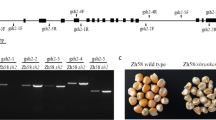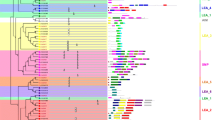Abstract
eEF1A appears to be a multifunctional protein in eukaryotes, where it serves as a protein synthesis factor as well as a cytoskeletal protein. In maize endosperm, the eEF1A concentration is highly correlated with lysine content, and eEF1A synthesis is increased in opaque2 mutants compared to wild type. To investigate the basis for the increased synthesis of eEF1A in opaque2, we characterized the genes encoding this protein and measured their relative level of expression in endosperm and other tissues. Maize contains 10 to 15 eEF1A genes that are nearly identical in nucleotide and amino acid sequences. However, these genes can be distinguished based on their 3′ non-coding sequences, which are less conserved. By screening endosperm and seedling cDNA libraries, we show that most of the maize eEF1A genes are expressed, and the relative level of their transcripts varies in different tissues. At least five genes are transcribed in the endosperm, and two account for ca. 80% of the RNA transcripts. The expression of several genes is enhanced in opaque2 endosperm, although the significance of this is unclear.
Similar content being viewed by others
References
Aguilar, F., Montandon, P. and Stutz, C. 1991. Two genes encoding the soybean translation elongation factor EF-1_ are transcribed in seedling leaves. Plant Mol. Biol. 17: 351–360.
Axelos, M., Bardet, C., Liboz, T., Le Van Thai, A., Curie, C. and Lescure, B. 1989. The gene family encoding the Arabidopsis thaliana translation elongation factor EF-1_: molecular cloning, characterization and expression. Mol. Gen. Genet. 219: 106–112.
Berberich, T., Sugawara, K., Harada, M. and Kusano, T. 1995. Molecular cloning, characterization and expression of an elonga-tion factor1 alpha gene in maize. Plant Mol. Biol. 29: 611–615.
Browning, K. 1996. The plant translational apparatus. Plant Mol. Biol. 32: 107–144.
Cao, H., Tong, Y. and Nes, W.D. 1997. Screening corn (Zea mays) cDNA library with yeast sterol methyltransferase gene results in the isolation of a full length cDNA encoding elongation factor 1-alpha. Plant Physiol. 113: 1463.
Cavallius, J., Popkie, A.P. and Merrick, W.C. 1997. Site-direct mutants of post-translationally modified sites of yeast eEF1A using a shuttle vector containing a chromogenic switch. Biochim. Biophys. Acta 1350: 345–358.
Clore, A.M., Dannenhoffer, J.M. and Larkins, B.A. 1996. EF-1_ is associated with a cytoskeletal network surrounding protein bodies in maize endosperm cells. Plant Cell 8: 2003–2014.
Collings, D.A, Wasteneys, G.O., Miyazaki, M. and Williamson, M. 1994. Elongation factor 1_ is a component of the subcortical actin bundles of characcean algae. Cell Biol. Int. 18: 1019–1024.
Dje, M.K., Mazabraud, A., Viel, A., Maire, M.L., Denis, H., Craw-ford, E. and Brown, D.D. 1990. Three genes under different development control encode elongation factor 1-_ in Xenopus laevis. Nucl. Acids Res. 18: 3489–3493.
Durso, N.A. and Cyr, R.J. 1994. Beyond translation: elongation factor-1_ and the cytoskeleton. Protoplasma 180: 99–105.
Edmonds, B.T., Murry, J. and Condeelis, J. 1995. pH regulation of the F-actin binding properties of Dictyostelium elongation factor 1-. J. Biol. Chem. 270: 15222–15230.
Edmonds, B.T., Bell, A., Wyckoff, J., Condeelis, J. and Leyh, T.S. 1998. The effect of F-actin on the binding and hydrolysis of gua-nine nucleotide by Dictyostelium elongation factor 1A. J. Biol. Chem. 273: 10288–10295.
Fonzi, W.A., Katayama, C., Leathers, T. and Sypherd, P.S. 1985. Regulation of protein synthesis factor EF-1_ in Mucor racemo-sus. Mol. Cell Biol. 5: 1100–1103.
Habben, J.E., Kirleis, A.W. and Larkins, B.A.. 1993. The origin of the lysine-containing proteins in opaque2 maize endosperm. Plant Mol. Biol. 23: 825–838.
Habben, J.E., Moro, G.L., Hunter, B.G., Hamaker, B.R. and Larkins, B.A. 1995. Elongation factor 1_ concentration is highly correlated with the lysine content of maize endosperm. Proc. Natl. Acad. Sci. USA 92: 8640–8644.
Hayashi, Y., Urade, R., Utsumi, S. and Kito, M. 1989. Anchoring of peptide elongation factor EF-1_ by phosphatidylinositol at the endoplasmic reticulum membrane. J. Biochem. 106: 560–563.
Hiatt, W.R., Garcia, R., Merrick, W.C. and Sypherd, P.S. 1982. Methylation of elongation factor 1 alpha from the fungus Mucor. Proc. Natl. Acad. Sci. USA 79: 3433–3437.
Jaskunas, S.R., Lindahl, L. and Nomura, M. 1975. Identification of two copies of the gene for the elongation factor EF-Tu in E. coli. Nature 257: 458–462.
Kaur, K.J. and Ruben, L. 1994. Protein translation elongation factor-1_ from Trypanosoma brucei binds calmodulin. J. Biol. Chem. 269: 23045–23050.
Kidou S. and Ejiri, S. 1998. Isolation, characterization and mRNA expression of four cDNAs encoding translation elongation factor 1A from rice (Oryza sativa L.). Plant Mol. Biol. 36: 137–148.
Kuriyama, R., Savereide, P., Lefebvre, P. and Dasgupta, S. 1990. The predicted amino acid sequence of a centrosphere protein in dividing sea urchin eggs is similar to elongation factor (EF-1_). J. Cell Sci. 95: 231–236.
Larkins, B.A. and Hurkman, W.J. 1978. Synthesis and deposition of zein in protein bodies of maize endosperm. Plant Physiol. 62: 256–263.
Lee, S., Wolfraim, L.A. and Wang, E 1993. Differential expression of S1 and elongation factor-1 alpha during rat development. J. Biol. Chem. 268: 24453–24459.
Linz, J.E., Katayama, C. and Sypherd, P.S. 1986. Three genes for elongation factor EF-1_ in Mucor racemosus. Mol. Cell Biol. 6: 593–600.
Liu, G, Tang, J., Edmonds, B.T., Murray, J., Levin, S. and Con-deelis, J. 1996. F-actin sequesters elongation factor 1_ from interaction with aminoacyl-tRNA in a pH-dependent reaction. J. Cell Biol. 135: 953–963.
Lund, A., Knudsen, S.M., Vissing, H., Clark, B. and Tommerups, N. 1996. Assignment of human elongation factor 1 genes: EEF1A maps to chromosome 6q14 and EF!A2 to 20q13.3. Genomics 36: 359–361.
McCreery, T. and Helentjaris, T. 1994a. Production of hybridization probes by the CPR utilizing digoxigenin-modified nucleotides. In: P. Isaac (Ed.), Protocols for Nucleic Acid Analy-sis by Non-Radioactive Techniques, Humana Press, Totowa, NJ, pp. 112–117.
McCreery, T. and Helentjaris, T. 1994b. Hybridization of digoxi-genin labeled probes to Southern blots and detection by chemilu-minescence. In: P. Isaac (Ed.), Protocols for Nucleic Acid Analy-sis by Non-Radioactive Techniques, Humana Press, Totowa, NJ, pp. 112–117.
Metz, A.M., Timmer, R.T., Allen, M.L. and Browning, K.S. 1992. Sequence of a cDNA encoding the alpha-subunit of wheat translation elongation factor 1. Gene 120: 315–316.
Moro, G.L., Habben, J.E., Hamaker, B.R. and Larkins, B.A. 1996. Characterization of the variability for lysine content in normal and opaque2 maize endosperm. Crop Sci. 36: 1651–1659.
Motorin, Yu. A., Wolfson, A.D., Orlovsky, A.F. and Gladilin, K.L. 1988. Mammalian valyl-tRNA synthetase forms a complex with the first elongation factor. FEBS Lett. 238: 262–264.
Nagata, S., Nagashima, K., Tsunetsugu-Yokota, Y., Fujimura, K., Miyazaki, M. and Kaziro, Y. 1984. Polypeptide chain elongation factor 1_ (EF-1_) from yeast: nucleotide sequence of one of the two genes for EF-1_ from Saccharomyces cerevisiae. EMBOJ. 3: 1825–1830.
Ohta, K., Toriyama, M., Miyazaki, M., Murofushi, H., Hosoda, S., Endo, S. and Sakai, H. 1990. The mitotic apparatus-associated 51-kDa protein from sea urchin eggs is a GTP-binding protein and is immunologically related to yeast polypeptide elongation factor 1 alpha. J Biol. Chem. 265: 3240–3247.
Page, R.D. 1996. TreeView: an application to display phylogenetic trees on personal computers. Comput. Appl. Biosci. 12: 357–358.
Pokalsky, A.R., Hiatt, W.R., Ridge, N., Rasmussen, R., Houck, C.M. and Shewmaker, C.K. 1989. Structure and expression of an elongation factor 1_ in tomato. Nucl. Acids Res 17: 4661–4673.
Ransom W.D., Lao, P.C., Gage, D.A. and Boss, W.F. 1998. Phos-phoglycerylethanolamine posttranslational modification of plant eukaryotic elongation factor 1". Plant Physiol. 117: 949–960.
Sanger, F., Nicklen, S. and Coulson, A.R. 1977. DNA sequencing with chain terminating inhibitors. Proc. Natl. Acad. Sci. USA 74: 5463–5467.
Seidler, L., Peter, M., Meissner, F. and Sprinzl, M. 1987. Sequence and identification of the nucleotide binding site for the elongation factor Tu from Thermus thermophilus HB8. Nucl. Acids Res. 15: 9263–9277.
Shen, B., Carneiro, N., Torres-Jerez, I., Stevenson, B., McCreery, T., Helentjaris, T., Baysdorfer, C., Almira, E., Ferl, R.J., Habben, J.E. and Larkins, B. 1994. Partial sequencing and mapping of clones from two maize cDNA libraries. Plant Mol. Biol. 26: 1085–1101.
Sun, Y., Carneiro, N., Clore, A.M., Moro, G.L., Habben, J.E. and Larkins, B.A. 1997. Characterization of maize elongation factor 1A and its relationship to protein quality in the endosperm. Plant Physiol. 115: 1101–1107.
Sutoh, K. and Mabuchi, I. 1989. End-label fingerprintings show that an N-terminal segment of depactin participates in interaction with actin. Biochemistry 28: 102–106.
Taylor, B. and Powell, A. 1982. Isolation of plant DNA and RNA. Focus 4: 4–6.
Thompson J.D., Higgins D.G. and Gibson, T.J. 1994. CLUSTAL W: improving the sensitivity of progressive multiple sequence alignment through sequence weighting, position-specific gap penalties and weight matrix choice. Nucl. Acids Res. 22: 4673–4680.
van Hemert, F.J., Amons, R., Pluijms, W.J., van Ormondt, H. and Moller, W. 1984. The primary structure of elongation factor EF-1 alpha from the brine shrimp Artemia. EMBO J. 3: 1109–1113.
Venema, R.C., Peters, H.I. and Traugh, J.A. 1991. Phosphorylation of elongation factor 1 (EF-1) and valyl-tRNA synthetase by pro-tein kinase C and stimulation of EF-1 activity. J. Biol. Chem. 266: 12574–12580.
Whiteheart S.W., Shenbagamurthi, P., Chen, L., Cotter, R.J. and Hart, G.W. 1989. Murine elongation factor 1 alpha (EF-1 alpha) is posttranslationally modified by novel amide-linked ethanolamine-phosphoglycerol moieties. Addition of ethanolamine-phosphoglycerol to specific glutamic acid residues on EF-1 alpha. J. Biol. Chem. 264: 14334–14341.
Yang, F., Demma, M., Warren, V., Dharmawardhane, S. and Con-deelis, J. 1990. Identification of an actin-binding protein from Dictyostelium as elongation factor 1_. Nature 347: 494–496.
Yang, W., Burkhart, W., Cavallius, J., Merrick, W.C. and Boss, W.F. 1993. Purification and characterization of a phosphatidylinositol 4-kinase activator in carrot cells. J. Biol. Chem. 265: 392–398.
Xia, X. 1999. DAMBE 3.0 (Software package for data analysis in molecular biology and evolution). Department of Ecology and Biodiversity, University of Hong Kong, Hong Kong.
Author information
Authors and Affiliations
Rights and permissions
About this article
Cite this article
Carneiro, N.P., Hughes, P.A. & Larkins, B.A. The eEFlA gene family is differentially expressed in maize endosperm. Plant Mol Biol 41, 801–814 (1999). https://doi.org/10.1023/A:1006391207980
Issue Date:
DOI: https://doi.org/10.1023/A:1006391207980




